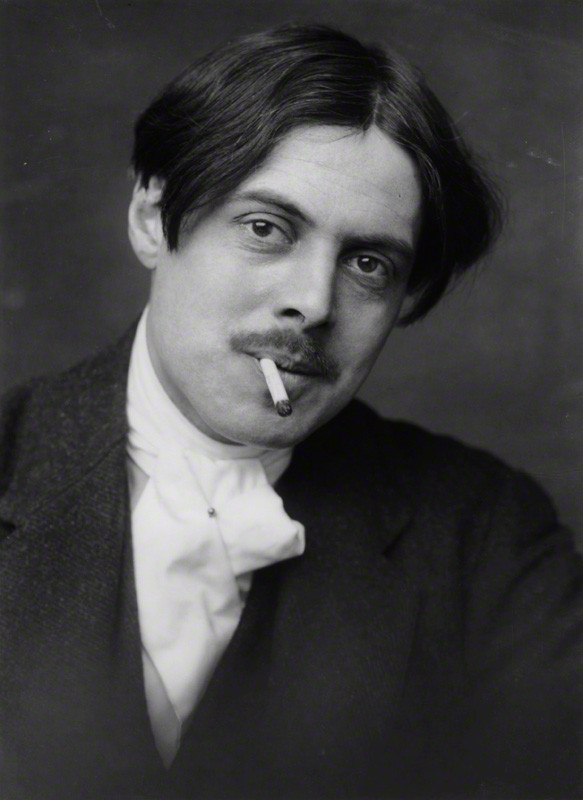The beginning of any artistic movement is typically unclear and shaky. Few have ever announced themselves with the audacity and verve of Vorticism. Discontented with tradition and inspired by the avant-garde spirit spreading across Europe, a group of young English artists assembled to create their own movement. It was dedicated to dynamism, machinery, abstract art, movement, and everything exciting about the future.
 Vorticism got its name from Ezra Pound, who identified the image of a vortex with the idea of a new breed of artist willing to embrace the oncoming maelstrom of modernity. The figure most associated with the movement is Wyndham Lewis, a writer and painter who, whatever his work’s merits, has fallen out of favor since he announced Nazi sympathies (that he later regretted this did not change much). His peers, including Ezra Pound, found him to be an inimitable prose stylist.
Vorticism got its name from Ezra Pound, who identified the image of a vortex with the idea of a new breed of artist willing to embrace the oncoming maelstrom of modernity. The figure most associated with the movement is Wyndham Lewis, a writer and painter who, whatever his work’s merits, has fallen out of favor since he announced Nazi sympathies (that he later regretted this did not change much). His peers, including Ezra Pound, found him to be an inimitable prose stylist.
Lewis introduced the world to Vorticism through a manifesto he published in the inaugural issue of BLAST in June, 1914. The piece was a 20-page yawp in jarring sans-serif, concrete-poem-like typesetting, which pronounced, more or less, the grievances and principles of a budding band of talented, somewhat bratty young artists. It “blasted” and “blessed” a pot-pourri of objects: things like journalists, cloudy English weather, snobbery, and those who feared ridicule were among those blasted, while sailors, hairdressers, and James Joyce were among those blessed.
The movement grew as one of the many tentacles burgeoning outward from the spirit of modernism in Europe. Vorticism was heavily invested in the direction of visual art. It rejected the traditional subjects of landscapes and figures and embraced the abstractions of Cubism, aiming to have paintings reflect the zest and dynamism of the industrial world. They liked bright colors and shapes with sharp, jagged edges. A still image that looked like it moved was the Vorticists’ platonic ideal.
 The movement could not help but be a kind of response to the Futurists in Italy, who also rejected bourgeoisie traditionalism and had a lust for speed, machinery, and even violence: anything that reflected the vitality of a new age. But Futurism’s founder, Filippo Marinetti, inadvertently alienated the English avant-garde as he attempted to court them, after putting their signatures on an artistic declaration they did never read. Wyndham Lewis, whose name was on the document, was incensed. In Lewis’s mind, it was frustrating to see an Italian take to the soapbox on such an issue. A movement positioned against cultural complacency and traditionalism should be taken up by Englishmen themselves. After all, it was the English who invented these ills in the first place.
The movement could not help but be a kind of response to the Futurists in Italy, who also rejected bourgeoisie traditionalism and had a lust for speed, machinery, and even violence: anything that reflected the vitality of a new age. But Futurism’s founder, Filippo Marinetti, inadvertently alienated the English avant-garde as he attempted to court them, after putting their signatures on an artistic declaration they did never read. Wyndham Lewis, whose name was on the document, was incensed. In Lewis’s mind, it was frustrating to see an Italian take to the soapbox on such an issue. A movement positioned against cultural complacency and traditionalism should be taken up by Englishmen themselves. After all, it was the English who invented these ills in the first place.
Vorticism, though managing to attract substantial artistic talent, was a short-lived affair. BLAST may have included a treasure trove of writers and artists—Rebecca West, Ezra Pound, and a section by Ford Madox Ford that would later become part of The Good Soldier—but it hardly succeeded as a periodical. Around a month after its publication, World War I broke out, and the world changed overnight. Lewis and company only managed to print one more issue, in 1915, as the war sapped both the artists’ energy and their numbers. The Vorticist painter and sculptor Henri Gaudier-Brzeska was killed in battle, while others like Lewis served in the war. They came home to unimaginable large-scale trauma and destruction. Efforts to revive the movement never stuck. The world, it seemed, changed even too fast for the future-forward Vorticists.









